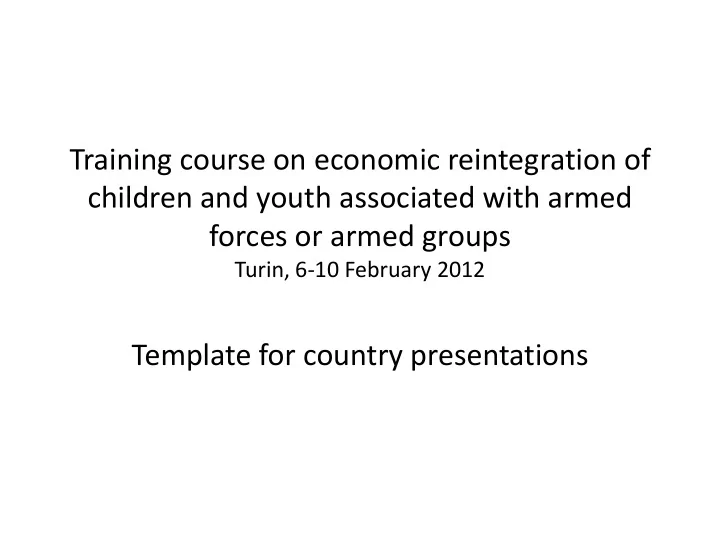

Training course on economic reintegration of children and youth associated with armed forces or armed groups Turin, 6-10 February 2012 Template for country presentations
(post) conflict situation in SOMALIA Somaliland Puntland South-Central Somalia Fragility level Fragile Post-conflict Conflict Political Aims to achieve Elected government Weak UN/int. community situation independence (2010) lead by Farole (his supported TFG Elected government son is openly linked to Al-Shabaab, ASWJ, and (2009) lead by Silanyo ex- piracy) other independent states SNM Introduced multi-party system in 2011 Economical Own currency Nat income from general Huge inflation situation Nat. Bank trade (Bossasso) and Nat income from UN/int. Nat income from livestock piracy ransom community [Brief description of the conflict or post-conflict situation (and level of trade to the Middle East Remittances Remittances political/social/economic instability or fragility), including the parties to Remittances Informal private sector conflict that use children in conflict-affected areas that are listed in the Annex Informal private sector of the SG’s report on CAAC. [3 minutes] Armed parties Clan militias e.g. Talex 2 Clan militia Clan militia using children Private company militia Freelance militia Freelance militia below 18 SSC ASWJ Nat. army Al-shabaab Galgala insurgents TFG Pirates Himan and Heeb forces Pirates
The use of children/youth in armed conflict Causes of Lack of alternative opportunities, education, government authority and recruitment protection; strong clan affiliation and protection; general radicalization; social status (masculinity); forced recruitment Circumstances SSC: (1) Self-demobilization (mainly AS, ASWJ) – gathered into TFG run in which they camp (Marino camp) released SL/PL/SSC: (2) Offered amnesty by the government in SSC/PL (3) Offered amnesty by the MoI/MoS but no legal framework yet (Law 63 in SL) (4) Alternative sentencing – parole/probation pilot in SL and PL in the framework of Youth at-Risk / Youth for Change project Approximate Official process in SSC 1000 (UNICEF under 18) proportion Self-demobilize 3000 in the whole Somalia (2011) Re- Especially into clan and freelance militia recruitment Official armies e.g. TFG Lack of prevention effort by the governments and aid agencies (first in its kind is the Youth at-Risk project)
Number of armed groups by category Local/internatio Private/market/ nal criminal neighbourhood groups Political/radical security armed groups Freelance militia Clan-based militia Proportion of groups including children (<18) = 62% Youngest members = 10 years old , but average around 14 years old , all in Mogadishu
Youth (18-30) associated with armed forces or armed groups Main (Data extracted via Youth-SMS software) characteristics Education: approx 30% illiterate; 30% semi-illiterate of above 18 Health: 4% disabled in SL/PL Family situation: 10% married; 30% orphan Attitude/behavior: criminal youth mainly opportunistic in SL and PL Community acceptance: not yet assessed/ quantified but specific image creating projects in within the social reintegration Main challenges - No legal framework yet to reintegration - Short term economical / social opportunities - Lack of conducive environment - Lack of culture of peace - Continuous crime/violence/conflict - Stigmatization of women - Managing expectations Skills vs school - Majority want to learn skills and work
Children (under 18) associated with armed forces or armed groups Children to be SL: 350 (2011/12); PL: 350 (2011/12); SSC: 500 (2004 – 2012) reintegrated Only males; possibilities for extending to SSC Main - Little to no education given lack of infrastructure characteristics - High numbers of street children, IDPs and other vulnerable youth of under 18 - Lower proportion of those formerly associated with armed groups - Information that under 18s are target of recruitment Main challenges - Desensitization of violence through 20 years of violence to reintegration - In Islam, 15 years constitutes adulthood - Children in current programs do not have access to economic aspects of reintegration - Lack of long-term educational support Skills vs school - SL: almost as many want education as those who want skills and jobs - Many under 18 have aspirations of starting their own businesses
Reintegration of children/youth Most youth have been reintegrated so far into urban environments Burco Bossaso - Traditional DDR did / does NOT work in Somalia - Alternative approach, which should not be alone standing but part of the wider community safety Galkayo that supports stabilization - Should be supplemented with community based policing and firearm registration Mogadishu - Transforms into continuous alternative sentencing - Bottom up – top down meet On-going Proposed in the middle at regional level
Evidence-based programming: Youth at-Risk/Youth for Change programme Goal: Improve Safety & Security at the Community Level Strategic Components: 1. Decentralized Partnership between the Community and the State Security Sector; 2. Sustainability ensured through Economic Integration coupled with Peace & Social Transformation ; 3. Link Security to longer-term development and stabilization; 4. Alternative Sentencing Probation / Parole mechanism
Target beneficiaries 700 Children & 1300 Adults Associated with Violence Hard Youth in Community Target Groups Criminals Target groups: 1. Former Armed Group Members (i.e. defectors); 2. Disenfranchise Children and Youths through community referral from Criminal Groups; 3. Individual Delinquent within the Community. 4. Youth in prison for petty crime or disciplinary reasons (Parole Mechanism); 5. Alternative sentencing - Youth via Police youth awaiting criminal court charge (Probation Mechanism);
Process Community Safety Mechanism < 18 Child Integration >16 Outreach Labor Profiling Intensive Enterprise/ Registration Validation Projects vocational training and support > 18 – Peace, Social, Economic Integration Case Management – Alternative sentencing
Economic Integration Curriculum Labour Vocational Intensive Training Project Labor Market Income Surveys Generating Skills training Activities Apprenticeship Enterprise Enabling Training Environment Business Business Development licensing, Skills/ Cooperative National Action Formation/ Grants Plans
END
Recommend
More recommend